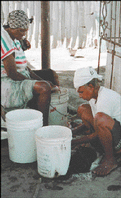
These vendors clean jacks at the Rocky Point Fish Market in Clarendon. Lately, they've been netting very few customers. Like other residents, they reject the notion that people in the area are bordering on starvation. - Dennis CokeBy David Williams, Freelance Writer
THE SLEEPY fishing community of Rocky Point, Clarendon, can count itself blessed with the volume and variety of its catches.
From snapper, jacks and grunts, to kingfish, parrot fish, sprats and more, it's no exaggeration to say that enough fish are landed at Rocky Point each day to feed the proverbial 5,000.
However, the community was recently listed among the "pockets of malnutrition" across the island, prompting the question as to how a village where fish are readily available and are a major part of the daily diet could rank as one of the most malnourished.
Along with Kitson Town in St. Catherine, Cambridge in St. Elizabeth and the Kingston inner-city community of Hannah Town, Rocky Point was named by a joint report of the Planning Institute of Jamaica (PIOJ) and the United Nations Development Programme (UNDP), as having a persistent level of malnutrition, particularly in children under age three. The report, which also notes almost one out of every three Jamaicans cannot access food which is "adequate for more than light activity", was based on data collected in 1997 and drew correlation between poverty and malnutrition.
'Business nuh slow, it a stan' up'
Rocky Point isn't the picture of a bountiful rural garden. Its dry, rocky soil seems to support the growth of thorn scrub more than anything else.
But then there is the sea. Lapping at their doorsteps it's the food basket, and chief money earner for most residents. Still, while the catch has been good, villagers say they haven't been faring too well lately. They've been netting few customers and, according to fishermen and vendors, they've been eating more fish recently, not only for the love of it, but because business has been so slow they've had to eat what they cannot sell.
"Through dem nuh fix di road nuhbody nuh come down ya fi buy. Business nuh slow, it a stan' up. It come like we don't even pon di map," said fisherman 'Fourteen Gun'.
Money may be hard to come by in Rocky Point, but residents rebuff suggestions they are malnourished.
"A lie dem a tell. A no dis Rocky Point. Yu nuh si how di whole a di ooman dem fat and round?," asked fish vendor Avis Ingram, pointing to her colleagues in the fish market.
"We don't want no more than two wenchman (fish), piece o' pumpkin, one 'Irish', two finger o' green banana, a piece o' pepper, chicken noodle and likkle butter. Dat is tonic. We caan malnourish," Mrs. Ingram said.
Her sentiments are likely echoed in communities across the island. The average Jamaican associates malnutrition with starvation - the face of famine-struck sub-Saharan Africa or the emaciated child with a distended belly, too weak to brush the flies away from his tear-stained cheeks, for example.
Malnutrition means more than simply not getting enough to eat, explained Dr. Erica Robinson, Assistant Professor of Nutrition and Science at Northern Caribbean University (NCU) in Mandeville.
Fat is a form of malnutrition
"Malnutrition, by definition, is poor nutrition," she said.
At the most basic level people become malnourished when they don't eat enough which means that the body doesn't get enough of the various micro-nutrients, she said.
Even people "with good size" can be malnourished and obesity is itself a form of malnutrition, she added.
"With obesity you've gone to the other extreme and poor eating habits have resulted in an excess accumulation of fatty tissue."
Dr. Robinson said she was pleased the people of Rocky Point had a high fish intake, but stressed that this did not necessarily mean they were well nourished.
"The fact they are eating a high intake of fish is good because it is probably meeting their protein requirements."
"But in order to be healthy you need a balance of nutrients from all the different food groups, including carbohydrates, fats, vitamins and so on. It may well be that they are getting enough protein but not enough of other nutrients," she said.
Ingrid Allen, a resident of the area, told The Gleaner that aside from what comes from the sea, there was no significant food production in Rocky Point.
"I would say about 30 per cent actually grow food to eat," said Ms. Allen, who sells fish outside the market. She added there was no significant amount of livestock rearing in the community.
Asked why residents don't pay greater attention to growing provisions and rearing livestock, the 29-year-old mother of two said, "Because we mostly depend on the sea. It's mostly fish we deal with."











































